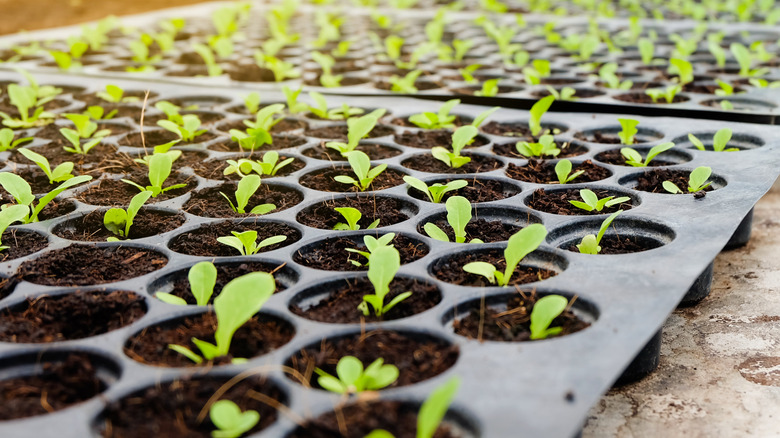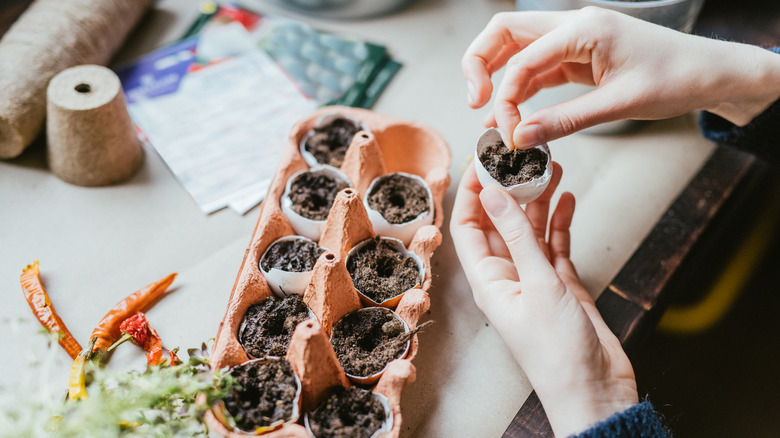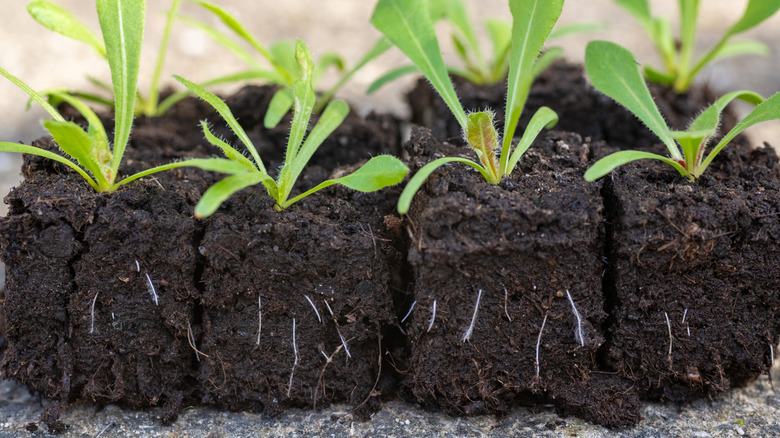Alternatives To Plastic Seed-Starting Trays
We may receive a commission on purchases made from links.
If you're the type of gardener who likes to have their hands in the dirt year-round, you're probably a seed starter. Cultivating seeds into small plants indoors before the warm weather arrives is a great way to get a jump start on the next gardening season — and keep some dirt under your nails. This type of seed starting (and then transplanting the seedlings) has many advantages, and helps ensure a thriving garden later in the year. It's also more economical to buy seed packets rather than purchase starter plants. And for most of the continental U.S., you can start your seeds as early as January. All of that seems great for the ecosystem, right? Believe it or not, there could be a hidden ecological cost to our green thumbs.
How you grow those seeds could have a major impact on the environment. Many gardeners sow their seeds in plastic containers. Because almost none of these petroleum-based products are accepted by single-stream recyclers, the majority of them end up in landfills. And we're talking as much as 1.66 billion pounds of horticulture plastic a year, based on data collected in 2009 — so there likely could be even higher amounts today. Not only do these pots and trays take hundreds of years to fully decompose, they also leach harmful chemicals into the soil and groundwater as they break down. Fortunately, there are now many alternatives to plastic pots that you can use to start your seeds this year.
Try these plastic-free options for seed starting
Instead of using plastic trays and pots for indoor seed germinating, there are many options to get your little sprouts growing. One alternative is to make your own trays or pots from products you have around the house such as egg cartons, toilet paper rolls, newspapers rolled into cylinders, moist paper towels, or even empty egg shells. With most of these options you must take care that they have decent drainage so they don't waterlog your seeds or become soggy and fall apart. Some of these options also take some labor on your part versus simply purchasing a pre-made tray.
Other plastic-free alternatives include potting products that break down in the soil over time such as small pots made from coir or coconut fiber, Growneer's paper pulp, Gardtree non-woven fabric, or even cow manure, like these CowPots. If you'd rather transplant your seedlings once they're ready, you can opt for small, reusable pots made from materials like terracotta, wood, or metal. A final option is bioplastics, which are pots or trays made from a plastic-like material that comes from organic sources such as sugar cane, corn, or other biological materials like tapioca starch. Unfortunately, not all bioplastic products are biodegradable or recyclable, so their ecological footprint is better ... but not perfect.
All of the above options work wonderfully for plants that benefit from an indoor start versus those that do best when sown directly outdoors. Many garden-variety vegetables that have long growing seasons or can't handle deep freezes make the list of optimal indoor starters, including lettuce, tomatoes, summer squash, and peppers, to name just a few.
From seed directly to soil -- no plastic needed
To avoid seeding trays and starter pots altogether, you'll either need to be planting directly into your garden at the appropriate time or using a product called a soil blocker. Some plants don't actually benefit from indoor seed starting and do better when sown directly into the soil at planting time. These are typically vegetables with larger seeds such as carrots, corn, onions, and watermelon. You won't get the benefit of an early start with these, but you also won't be messing around with extra materials to get them started.
Another option is a nifty tool such as this Nanovi soil blocker. This device is simply a metal press that's used to squeeze moist potting mix into compact blocks of dirt with a depression at the top for a seed. These come with a bit of a learning curve, but are a better way to start plants because they lead to healthier root growth than when grown in a pot. Then, just transplant these blocks directly into your prepared garden bed for planting.
If you still find yourself wanting to give your garden an early indoor start, think about trading potting materials with community members or neighbors. You can also look at organizations working to reduce plastic use in horticulture such as the Healthy Pots, Healthy Planet coalition. The USDA is also mobilizing to fight plastic waste with a website dedicated to procuring biofriendly products. Their BioPreferred Catalog lists eco-friendly suppliers and manufacturers, including gardening supplies and accessories. You can check your local nursery or greenhouse for some of these innovative, plastic-free products.


